Fröbel and the Gifts of Kindergarten
Cultivating the modern child in the garden of play
Norman Brosterman
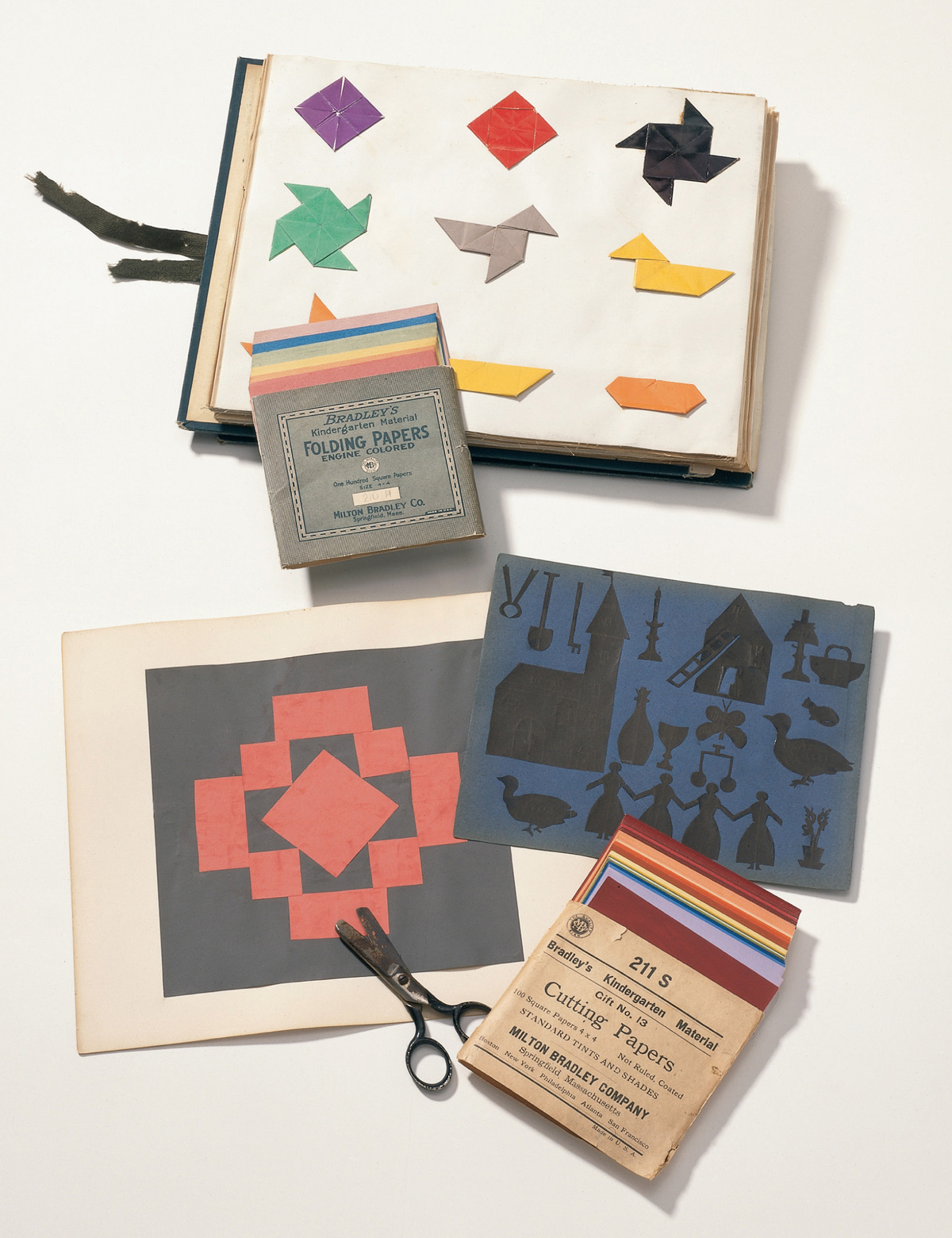
Kindergarten has been around so long, and is so thoroughly familiar, that it is natural to assume personal expertise on the subject. But kindergarten for us, and for most of the generations born in this century, is a distortion, a diluted version of what Friedrich Wilhelm Fröbel (1782–1852) originated as a radical and highly spiritual system of abstract design activities developed to teach the recognition and appreciation of natural harmony. Kindergarten has always included singing and dancing, as well as observation of the workings of nature—the growth of plants, the symmetries of crystals and seashells. One’s teacher was usually a woman and she led the class in activities that would have been considered play outside the school. But long abandoned, and thus hardly known today, is the practical and philosophical heart of the system—Fröbel’s interconnected series of twenty play “gifts” using sticks, colored paper, mosaic tiles, sewing cards, as well as building blocks, drawing equipment, and the gridded tables at which the children sat.
The son of a Lutheran minister, Fröbel was born in Oberweissbach, a forest town in central Germany. A lonely boy with a neglectful stepmother and distracted father, he formed an unusual kinship with nature that blossomed into spiritual exaltation during the height of the Romantic era. The works of his contemporaries Goethe and Schiller added to Fröbel’s intuited cosmology, and he fashioned a personal philosophy of Unity—embracing the spiritual potential within a person, relations between people in a free society, the place of the individual in relation to the nature that surrounds and includes him, and the life force that controls growth in all things—as both a permanent goal and working gauge.
The names Johann Heinrich Pestalozzi and Christian Weiss may ring no bells today, yet through the agency of their mutual pupil Fröbel, their influence was profound. Pestalozzi (1746–1827) was one of the first educators to abandon the standard instructional practice of interminable lectures followed by student recitation in favor of more active, hands-on activities and what he termed Anschauung—“object lessons,” or direct, concrete observation. At the school he opened in Yverdon, Switzerland, in 1804, Pestalozzi’s success with orphans and the previously disenfranchised children of the working class altered the course of modern education.
The traditional educational activity of drawing was greatly emphasized at Yverdon, as Pestalozzi considered it of primary importance in the teaching of writing and comprehension of form. Recognizing that children manifested a natural “taste for drawing,” and just as commonly, an aversion to the study of letters, Pestalozzi developed techniques that incorporated a combination of both. In their joint publication of 1803, ABC der Anschauung, his assistant Johannes Buss went so far as to construct an experimental “alphabet” of form consisting of various segments of lines drawn in the squares of a gridded matrix.[1] Abstract and unintentionally iconographic, the ABC was a tool developed to facilitate observation and the learning of writing by fragmenting letters and pictures into their basic components. Pestalozzi hoped to create a method whereby any series of letters called out to little children would be immediately comprehensible in specific visual form. So, for example, “L2B3” might mean a short diagonal followed by two long horizontals. Like quirkily coded versions of Sol LeWitt’s wall drawings, the system was inherently confusing and short-lived.
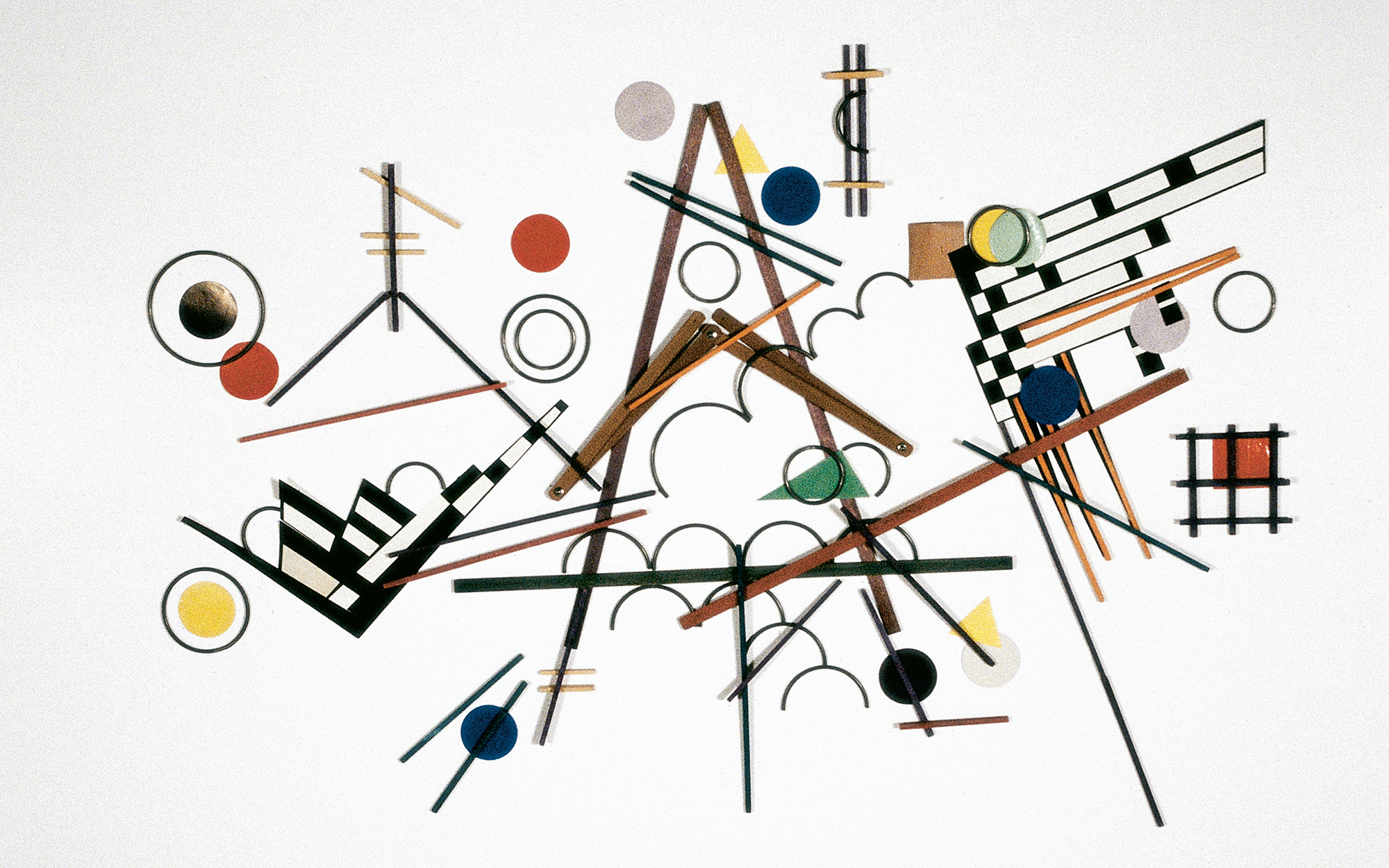
Fröbel’s first visit to Yverdon was in 1805. Two years later, after acting as a private tutor in Frankfurt, he returned to teach under Pestalozzi and stayed until 1810. At Napolean’s defeat in 1814, after stints as a forester, teacher, and soldier, Fröbel took an assistant’s job at the Mineralogical Museum of the University of Berlin under Professor Christian Samuel Weiss (1780–1856). From 1811 to 1815, coincident with Fröbel’s tenure in the museum, Weiss was in the process of formulating the theoretical parameters and objective techniques of modern crystallography, changing the field from a branch of natural philosophy to an exact mathematical science. Before the twentieth century, when the existence of atoms was finally confirmed with the invention of X-ray diffraction, the naturally occurring forms of crystals were correctly assumed to be external manifestations of the regular arrangement of minute particles in three-dimensional matrices. It was the genius of Fröbel’s mentor Weiss to recognize that the number, type, and relative direction of a specimen’s observable geometric symmetries distinguished its unique internal structure, and would ultimately reveal its specific chemical composition.
Fröbel worked each day for almost two years in a “locked and perfectly quiet room” organizing the diverse and dazzling samples of the mineralogical museum’s splendid omnibus collection.[2] The shapes of crystals in particular—the systematic variations in the design of their forms, planes, and symmetries—provided an obvious structure for the categorization of mineral classes, ultimately leading to Weiss’s discoveries.
For Fröbel, inclined as he was to view nature as a great work of design by a higher power, this intense and prolonged occupation with the geometric handiwork of God had a profound and lasting impact. He began to perceive “transforming, developing energy” in the smallest fixed forms of nature’s infinite palate and learned to recognize people, plants, and crystals as equivalent consequences stemming from the same laws of growth: “And thereafter my rocks and crystals served me as a mirror wherein I might descry mankind, and man’s development and history. … Nature and Man now seemed to me mutually to explain each other, through all their numberless various stages of development.”[3] What once seemed obvious to Fröbel about living things—that their essential growth was governed by fixed laws from above—now also resonated in mere stones. Furthermore, and more significantly for the generations to follow, he discovered forms of symbolic unity that could, with pencil and straightedge, be transferred to paper and bound into books. Simply put, Fröbel postulated that since the shapes of crystals—combinations of triangles and tetrahedrons, squares and cubes—are the outcome of the same natural laws that also result in the growth of children, people, and entire societies, handling these forms correctly would reveal and illuminate the mind of the creator itself.
In 1816, Fröbel declined a professorship of mineralogy in Stockholm in favor of founding his first small school for children. After teaching around Germany and Switzerland for another twenty years, he concluded that when many children began school at the officially mandated age of seven, a rigid dullness was too often already fixed within them. In 1837 in the spa town of Blankenburg, Fröbel opened his first institution for the very young. Two years later, he exultantly fixed upon a brand-new word to describe his revolutionary invention, “kindergarten,” which encapsulated in a single clever neologism two related ideas: its organizational model (the children’s garden) and its spiritual foundation (the garden of children).
After formulating the explicit lesson of kindergarten (growth and interconnectedness), Fröbel designed physical tools (models of natural crystals, or the gifts) that he theorized would lead to its comprehension. He simultaneously created a methodology that when properly utilized, provided children with an infinite number of conceptual links between the two—exercises in what were usually called the “Three Realms.” In short sessions of directed play, the geometric gifts were used to create pictures or structures that fit loosely into each of three fundamental categories—forms of Nature (or Life), forms of Knowledge (or Science), and forms of Beauty (or Art). Unlike the building blocks, mosaic toys, and traditional crafts that were their forbears, the gifts were never available for entirely “free play.” Always tethered in some fashion to the forms of the three realms, their use was subordinate to the greater whole, which was Unity.
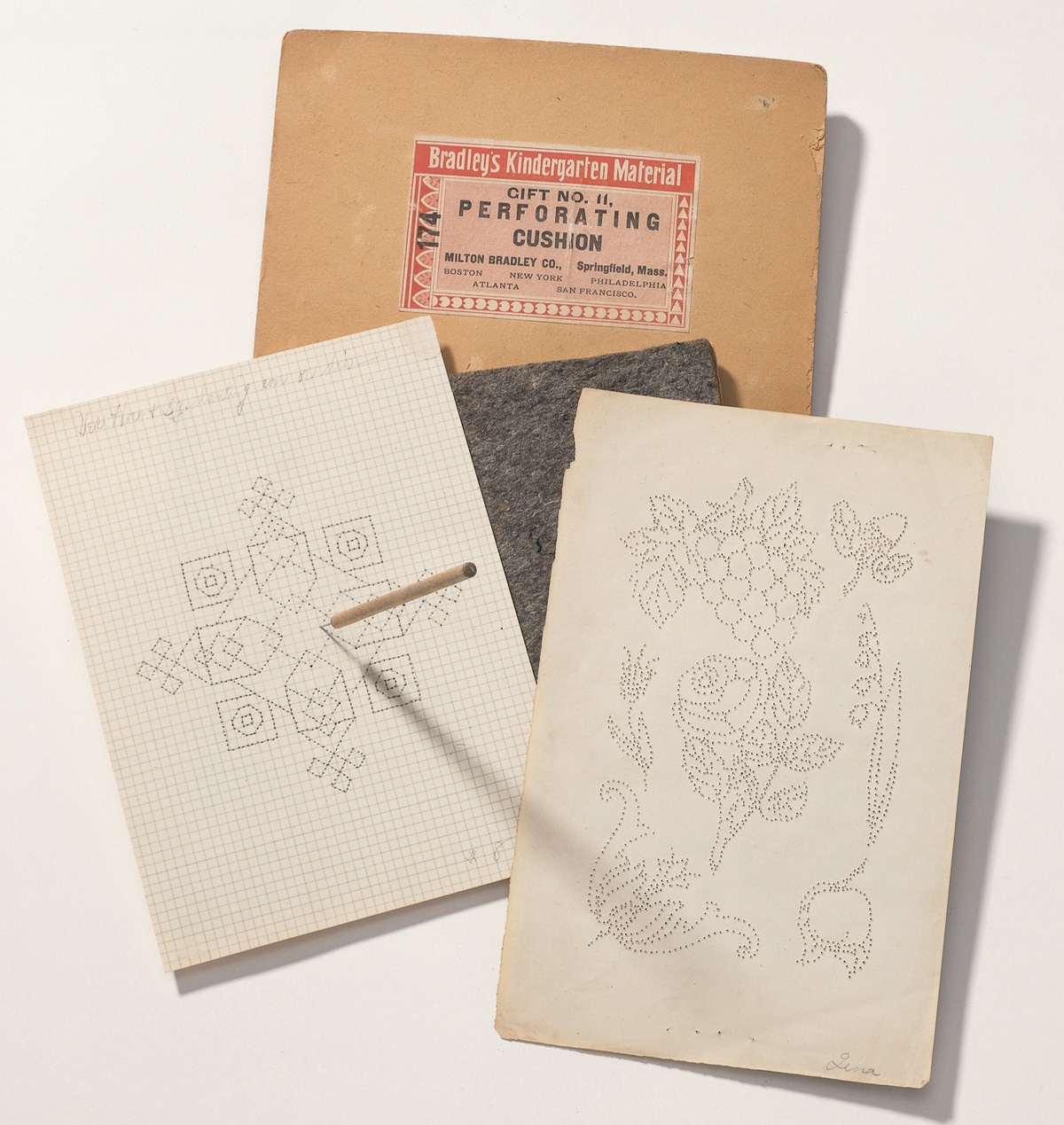
The life forms were tangible: chairs, trees, people; the knowledge forms mathematical: 2×4=8, 4+4=8; the beauty forms were usually symmetrical patterns, as Fröbel felt symmetry was most comprehensible as beauty to little children. Equivalency was kindergarten’s foundation and it was expressed in all things and at all times. For four-, five-, and six-year-olds, transforming the very same materials into something new each day, as the class shifted from gift to gift and from realm to realm, the ultimate lesson of kindergarten was straightforward. In slightly different guise, the world, mathematics, and art were interchangeable, and their perceived borders were misleading, artificial constructs. A chair might become numbers, numbers art, and art either or both. With extremely simple means, former crystallographer Fröbel effectively assembled all the components of the universe into his training program for infants. Children could make anything they saw, perceived, or imagined, and while doing so would enter the world—and it would enter them.
The original kindergarten spread successfully around the world in the decades after Fröbel’s death in 1852. It was particularly popular in Holland, Italy, France, Switzerland, Great Britain, Japan (the first school opened in 1876), Canada, and the United States. Publicly banned in Germany as a result of the failed revolution of 1848, it was maintained there in private, liberal, and Jewish schools until its complete acceptance in the early twentieth century. Through the efforts of missionaries, it soon became a fixture in almost every country on earth, and the German word “kindergarten” is still found in the dictionaries of a great number of totally unrelated languages.
The original function of Fröbel’s system as a spiritual guide to the “music of the spheres” was bastardized in some countries and certain schools from the time of its inception. Yet all of the gifts remained essentially unchanged and in general use until at least 1910, and in some areas, well after. From 1860 on, millions of little children in Europe, North America, and Japan began their education in Fröbel classes, and significantly, their parents did not, so that the generation that came to maturity before World War I was comprised of the prime recipients of the original crystalline kindergarten, before a few of them grew up and invented abstract painting and modern architecture.
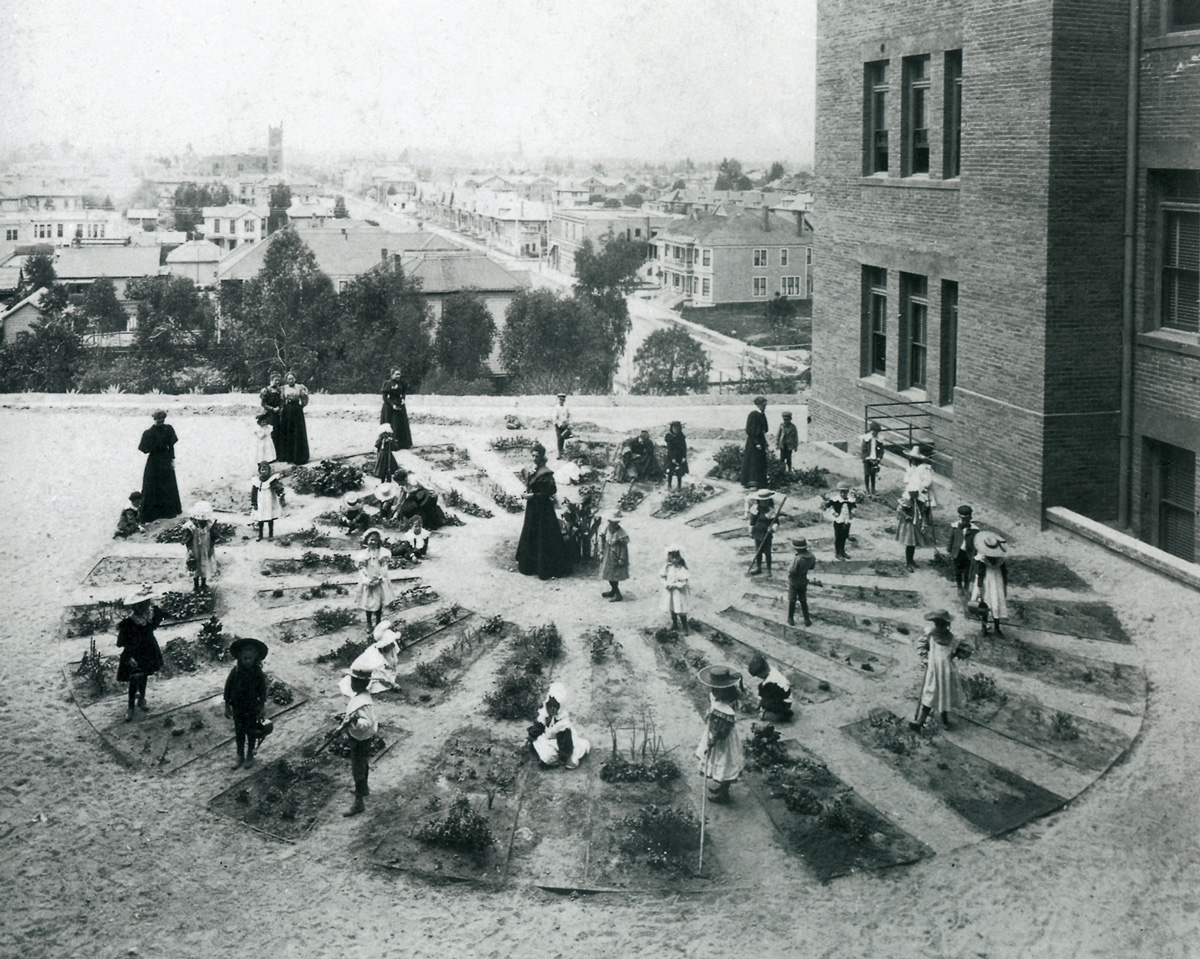
Because nineteenth-century children in countries from Austria to Australia were required to learn a new form language as a requisite of kindergarten, the system’s proliferation resulted in unforeseen consequences tangential to, but significantly removed from, Fröbel’s explicit lesson of Unity. By connecting the gift plays to an abstract mode of expression, the early kindergarten pedagogues in effect created an enormous international program designed specifically to alter the vision of the general populace. While focusing on kindergarten’s many educational and social benefits, they overlooked a potentially radical outcome of their efforts that is obvious in retrospect—kindergarten taught abstraction. In its explicit equivalency of ideas and things it taught abstract thinking, and in its repetitive use of geometric form it taught a new way of seeing that was utterly unfamiliar to the preceding generation. In 1882, Marie Matrat, the Inspectrice Générale of the French national kindergarten system, or écoles maternelles, declared in exasperation:
Even the best headmistresses have visible form as their first concern! Rather than resorting to a few random exercises, which might even be called improvised, they have made it into the dominant portion, and the actual objects surrounding the children remain forever forgotten. In a word, these games, rather than being preparation, are the actual teaching.
Three little sticks held like a fan is a vase of flowers; a collection of triangles, laid out according to a given pattern, is a factory, a tomb, a log, the mechanism of a windmill, a hundred things the child has never seen, which he cannot represent using these trinkets, except by using fantasy. Such representation so little resembles the real object that even with the best of intentions, for me it was impossible to ever recognize the object.[4]
While it is probable that Frank Lloyd Wright began his kindergarten training years before his mother supposedly “discovered” the gifts at the 1876 Philadelphia Centennial, there is no question about the system’s profound effect on his architecture. As one of the few kindergarten kids to write about his early experiences, Wright’s words are extremely valuable:
Mother learned that Frederick Froebel [sic] taught that children should not be allowed to draw from casual appearances of Nature until they had first mastered the basic forms lying hidden behind appearances. Cosmic, geometric elements were what should first be made visible to the child-mind.
Taken East at the age of three to my father’s pastorate near Boston, for several years I sat at the little kindergarten table-top ruled by lines about four inches apart each way making four-inch squares; and among other things, played upon these “unit-lines” with the square (cube), the circle (sphere) and the triangle (tetrahedron or tripod)—these were smooth maple-wood blocks. Scarlet cardboard triangle (60°–30°) two inches on the short side, and one side white, were smooth triangular sections with which to come by pattern—design—by my own imagination. Eventually I was to construct designs in other mediums. But the smooth cardboard triangles and maple-wood blocks were most important. All are in my fingers to this day.
Also German papers, glazed and matte, beautiful soft color qualities, were another one of the “gifts”—cut into sheets about twelve inches each way, these squares were slitted to be woven into gay colorful checkerings as fancy might dictate. Thus color sense awakened. There were also ingenious “constructions” to be made with straight, slender, pointed sticks like toothpicks or jack-straws, dried peas for the joinings, etc., etc. The virtue of all this lay in the awakening of the child-mind to rhythmic structure in Nature—giving the child a sense of innate cause-and-effect otherwise far beyond child-comprehension. I soon became susceptible to constructive pattern evolving in everything I saw. I learned to “see” this way and when I did, I did not care to draw casual incidentals of Nature. I wanted to design.[5]
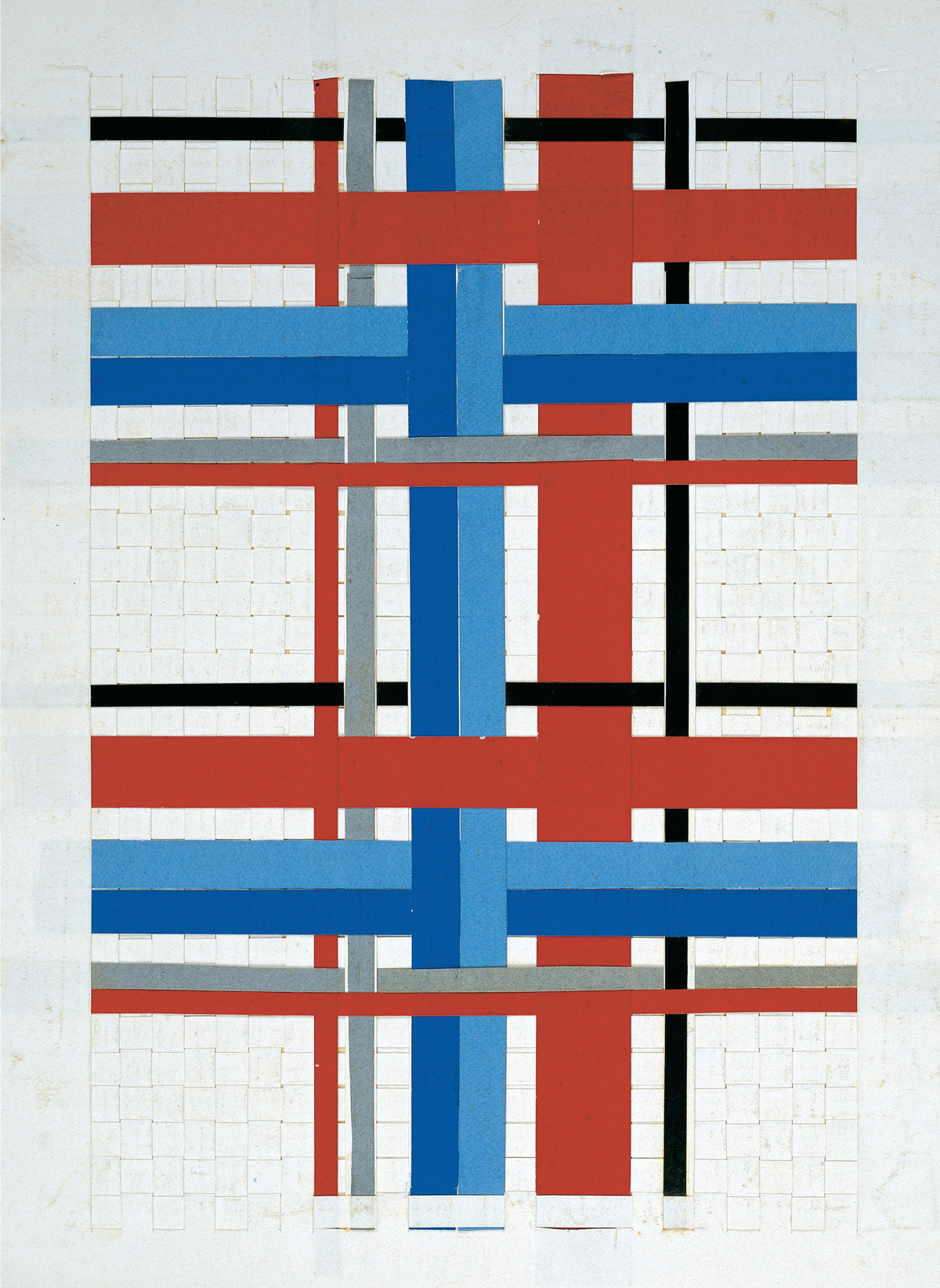
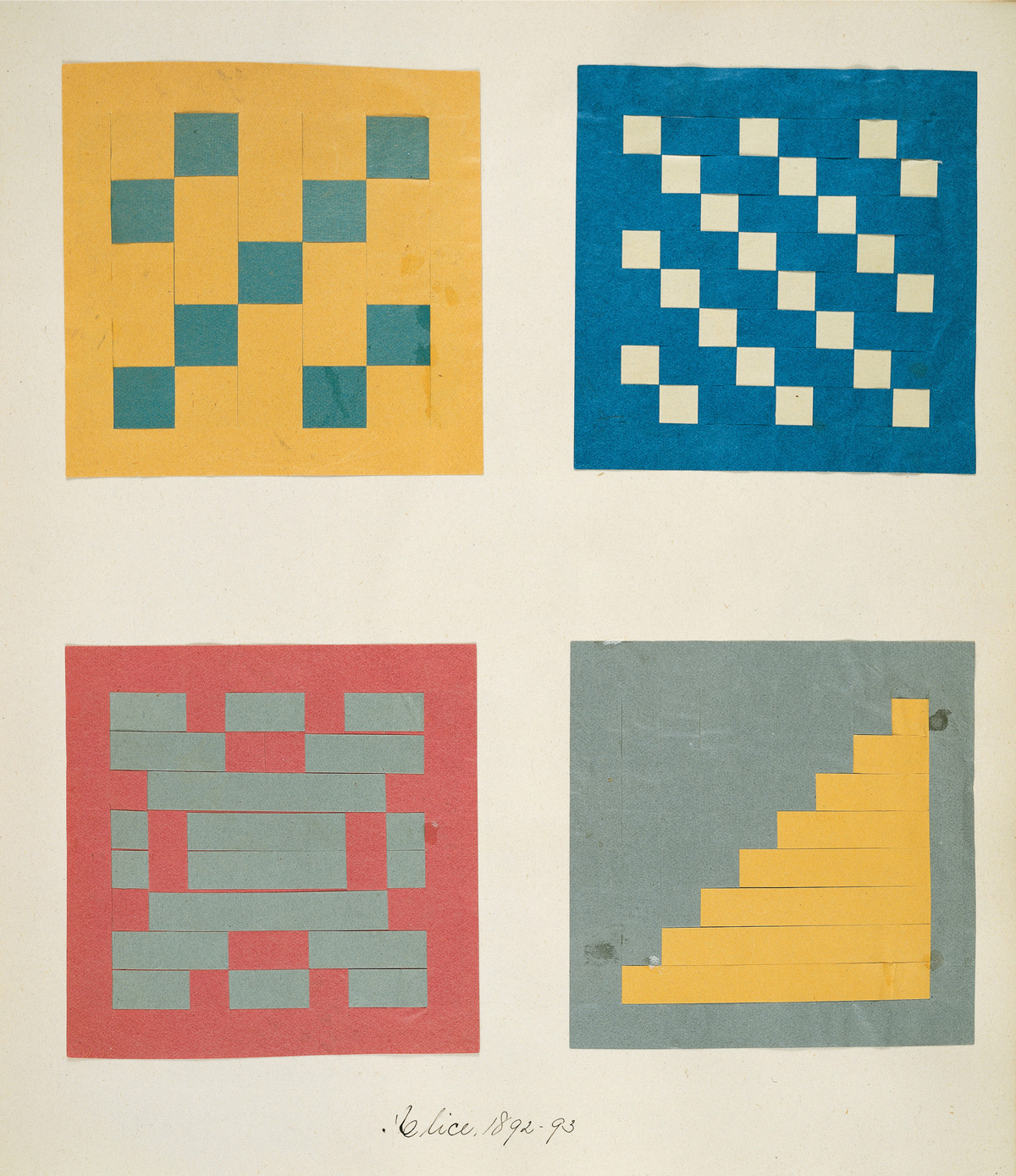
If Wright were the only important twentieth-century respondent to the kindergarten pedagogy, we would still owe a debt to Fröbel’s persistent dream. But there were others. Vasily Kandinsky attended one of the very first Italian kindergartens in Florence, where he was living with his parents in 1870. Fröbel’s twenty gifts, which deliberately deconstructed nature from solid to plane to line to point and back, bear a close resemblance to the components of his Bauhaus paintings. Johannes Itten, first Master of Form at the Bauhaus and creator of its revolutionary Vorkurs, was a Fröbelian kindergarten teacher in Vienna before Walter Gropius invited him to Weimar in 1919. In 1889, at the age of seventeen, Piet Mondrian won his license to teach drawing in Dutch primary schools like his father before him. Pedagogical drawing for little children in Holland at that time entailed the systematic construction of increasingly complex geometric designs on right-angle grids. It was identical to the netzzeichen (net drawing) Fröbel first proposed in 1826 as a response to Pestalozzi’s ABC der Anschauung. It was also kindergarten gift number ten, in public use in Holland along with the rest of the system since 1860. On 1 September 1891, even before his fourth birthday, Charles-Édouard Jeanneret, the future Le Corbusier, began his studies in the École Particulière of La Chaux-de-Fonds, Switzerland run by one of the first graduates of the new state-mandated Neuchâtel Fröbelian Normal School, Mlle. Louise Colin. After three years in this private kindergarten, Jeanneret took the equivalency examinations that allowed him to enter the public primary school, which, as per an 1889 law, was also structured along Fröbelian lines.[6]
The grid of the kindergarten table became a very real model of a type of inquiry that drew from multiple sources, cut across and connected seemingly divergent data, and had the potential to result in more than one “correct” conclusion. In its tacit acceptance of abstraction, kindergarten taught intellectual diversity and the value of unconventional reasoning. And due to the configuration and particulars of play with the gifts, the daily activities in any average kindergarten exhibited affinities with nothing so much as an introductory course in the mechanics of art and architecture. The children thus exposed might have been expected to eventually focus these primary experiences toward art, and some definitely did. Yet paradoxically, while mimicking some of the traditional activities of real art making, the specific forms of the kindergarten were inherently ill-suited for actually emulating European art and architecture of the late nineteenth century, or for that matter, any other epoch. But crowded around the grid of the kindergarten table in their lace and velveteens, what the first great kindergarten generation could do well, and what they all did to some degree, was to systematically transform the gifts into the kind of crystalline expressions associated with another art; a new art that would become the next art, early modernism, the art of their future.
The Victorian childhood of the seminal Modernists coincided with the development and widespread embrace of a radical educational system that was a catalyst in exploding the cultural past, and restructuring the resulting intellectual panoply with a new world view. It was never fodder for artistic argument over absinthe and Gauloises in Montmartre cafés, nor was it taught at the tradition-bound academies. It has been largely ignored because its participants—three-to seven-year-olds—were in the primary band of the scholastic spectrum. It was the seed pearl of the modern era and it was called kindergarten.
The recreation of Vasily Kandinsky’s Composition 8 was published in the wrong orientation in the print edtion of this issue. We regret the error.
- Johannes Buss and Johann Heinrich Pestalozzi, ABC der Anschauung, oder Anschauungs-Lehre der Massverhältnisse (Tübingen: J. G. Cotta, 1803).
- Friedrich Froebel, Autobiography of Friedrich Froebel, trans. Emilie Michaelis and H. Keatley Moore (Syracuse, NY: C. W. Bardeen, 1889).
- Ibid.
- Marie Matrat, “Les Écoles Gardiennes de La Hollande,” in Revue Pedagogique (1883), p. 312.
- Frank Lloyd Wright, A Testament (New York: Horizon Press, 1957), pp. 19–20.
- See Marc Solitaire, “Le Corbusier et l’urbain: la rectification du damier froebelien,” in H. Allen Brooks, ed., La Ville et L’Urbanisme après Le Corbusier (La Chaux-de-Fonds: Editions d’En Haut, 1993).
Norman Brosterman is the author of Inventing Kindergarten (Harry N. Abrams, 1997).
Spotted an error? Email us at corrections at cabinetmagazine dot org.
If you’ve enjoyed the free articles that we offer on our site, please consider subscribing to our nonprofit magazine. You get twelve online issues and unlimited access to all our archives.